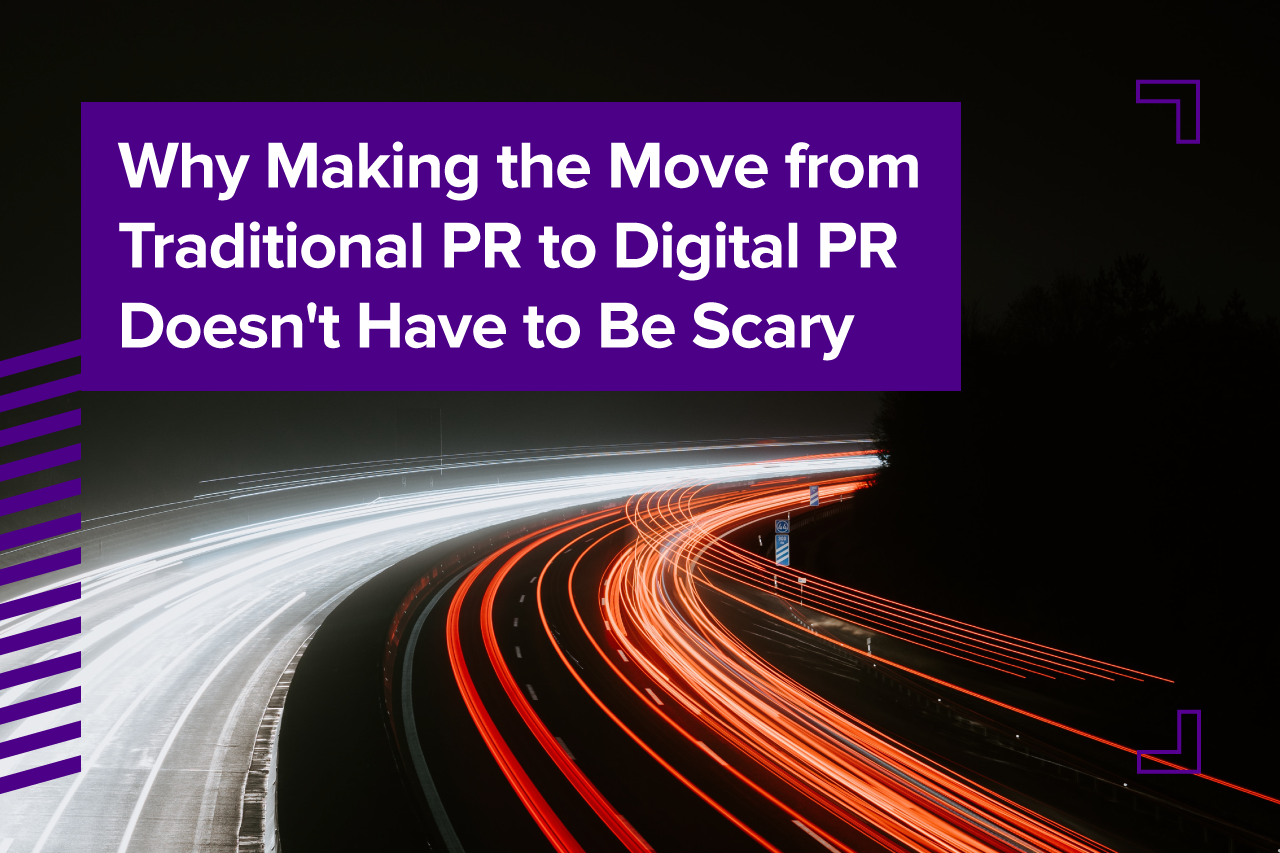The Biggest Pop Culture Moments of 2023
News

03 / 03 / 22
There’s a lot to be said about the differences between digital and traditional PR, but what if you’re thinking of making the switch to digital after a long stint at the other end? The truth is, there isn’t a whole lot to worry about.
When I finished university, I fell in love with PR after being given the opportunity to attend a graduate day at one of Manchester’s biggest firms. The idea of getting to work at events and write content that could end up printed in UK national newspapers excited me, and I couldn’t wait to get stuck in.
After landing my first job in traditional PR, I soon learnt all the ins and outs of what my new job role meant and how to achieve the best coverage for clients. I immediately knew that this was where I wanted to take my career — without ever really thinking about what working in digital PR could mean.
When the pandemic hit, I started to consider some new options, and what aspects of PR I was really interested in, by taking part in online courses like Google’s Fundamentals of Digital Marketing. I soon came to realise that something was missing for me when it came to traditional PR.
Fast forward to November 2020 — when I was offered a job at JBH. The idea of going from being someone who understood the traditional PR industry very well to traversing entirely new terrain in digital PR was quite a daunting prospect. Would I fit in with the digital PR world? What if this was a massive career mistake?
Truthfully — there was absolutely no reason to worry. I had plenty of skills built up from my university degree and experience from working in traditional PR — which made the process of transitioning to digital a lot smoother than I originally anticipated.
I started out as a Junior Digital PR Executive at JBH, learning new skills as I went along. Nonetheless, the more I asked questions, the quicker I realised I already had valuable experience that would help me excel in my new role.
Writing Copy
Having done a degree in sociology, I was already familiar with writing long pieces of content in tight deadlines, while paying strict attention to detail. This meant that when faced with large amounts of copy and landing pages, I was able to quickly adapt my skills to new challenges.
A hugely valuable skill I’d already learned from working in traditional PR was knowing how to pitch email to journalists in a way that makes them want to cover your story. This is a tactic that can constantly be improved upon, but knowing the right buzzwords and angles to employ works just the same in digital PR.
Building relationships with journalists
Whether you’ve been working in PR for years, or you’re completely new to the field, we all know that a core aspect of PR is building relationships with journalists so you can get coverage for your clients. Time and again since working in the industry, I’ve proved to myself just how crucial this is.
In terms of how to build these connections, the playing field may have changed somewhat over the past few years — but nurturing these relationships remains just as important. When I began my career, creating connections often involved calling the publication or journalist to speak with them directly, and pitching over the phone. But a few years and a global pandemic down the line, journalists now prefer to be contacted via email — which can make developing a rapport that little bit more tricky.
I’ve found that the best way to tackle this issue is to be as direct as possible and take the plunge. Put simply — in the PR world, if you don’t ask, you don’t get. Telling a journalist what clients you work on, and asking if they’re interested in that type of content, will often go a long way — and might even lead to them coming to you directly next time they need a comment on a specific topic.
Perseverance and determination
If working in PR has taught me anything, it’s that not all of your ideas and campaigns will land the way you want them to. Try not to get disheartened by this fact, because there’ll always be a new idea you can try, and the one thing that has produced the most results for me across both traditional and digital media is perseverance.
I actually experienced this fairly recently with our study that looked at the ‘broadband issues we find the most annoying’ — a campaign we did for UK-based price comparison platform, Uswitch. A design-led campaign, we pitched this around Halloween in the hope that the graphics would lead the coverage — but despite Vuelio (a commonly used digital PR media database) showing over 25% email open rates when pitching, the lack of data to back up the designs made it hard to tell a story.
This is where determination and a little perseverance came into play. When Facebook, Instagram, and Whatsapp had a 24-hour outage, I saw a great way to drive some links to our campaign. Using data from Down Detector, we quickly calculated how many times some of the world’s biggest sites had experienced outages, and pitched it out to journalists — linking back to our campaign. Within days, we managed to achieve coverage in publications like ZDNET, The Register, and B&T magazine.
While my previous job in traditional PR did help facilitate a much smoother transition into digital PR, making the switch wasn’t without its challenges, and I found that I still had a lot to learn to truly settle into my role.
Understanding SEO
SEO (Search Engine Optimisation) helps increase your company’s exposure on search engines — and it’s one of the main ways digital PR differs from traditional PR when it comes to strategy.
Traditional PR operates a more direct approach when generating brand awareness — by getting the customer to buy into the brand with things like promotional products and events.
In digital PR, the approach is a lot more subtle — and often, it doesn’t matter if you don’t reach the customer base. Instead, SEO works by impressing Google with high-ranking keywords and follow links that go back to the brand you’re representing.
When I moved to digital PR, the SEO aspect was something I had to quickly get my head around in order to understand the point of the campaigns we were executing and why they mattered. That’s just a small part of the power of SEO, too — there’s plenty more that I’m looking forward to learning as I progress my career in digital PR.
Working with big datasets
One major challenge as I transitioned from traditional to digital PR was working with the large data sets that often form the basis of our campaigns. While digital campaigns take on many forms, using data to create a story works really well, and can generate some amazing results for your clients.
Although I had managed large datasets before — having worked for a short time in admin — using numbers to generate coverage for journalists was an entirely new concept for me, and to begin with, I found it quite overwhelming.
However, the more I spent time working on and processing my own sets of data, the easier it became for me to see where the stories were, along with the angles I wanted to pursue and could achieve. If, like me, you’re better with words when it comes to your career, I really recommend spending time with the data specialists on your team, so you can pick their brains about anything you might be unsure about.
Having confidence
Whether you’re great at your job, or have recently made a big career change, there comes a point in everyone’s careers where they lack confidence in their own abilities — whether it comes from a place of self-doubt, or criticism you may have received in the past.
Making the switch to digital PR is not without its challenges — but while these may make you doubt your own abilities, there are plenty of ways to find your feet and self belief again.
One of the biggest factors that helped reignite my confidence while working in digital PR was seeing the results of my hard work. There’s nothing better than the excitement you feel when the ‘ping!’ from a high domain authority link for your client comes through. There are plenty of other ways to gain a little bit more confidence while adapting to the digital PR industry, too — including social media, books, and more.
While I enjoyed my time in traditional PR, there are plenty of benefits that come with working in digital that make the day-to-day just that little bit more exciting.
It’s easier to see the results of hard work
One of the biggest benefits of working in digital PR is seeing the results of your hard work paying off — whether that’s reaching a KPI link target, or scoring high domain authority links.
Traditional PR is a bit more tricky when it comes to tracking the success of your campaign and what effect it’s had on your client’s brand. For example — 100,000 listeners might have tuned in to a news broadcast or radio segment for your brand, but it’s difficult to know how many of those people were paying attention, and whether they will want to buy into your client’s products.
You can reach audiences on a global scale
One part of my role that I love is being able to outreach my campaigns on a global scale, and access audiences I never have before.
In traditional PR, it can be harder to have the same kind of impact on global audiences, but that doesn’t mean that you can’t hit the right demographics. In fact, when it comes to strategy, depending on who you want to target might influence whether you opt for a traditional or digital PR strategy. For example, if you wanted to target older generations, you might opt for worldwide print coverage, as this is a demographic that tends to be less tech-savvy.
More breathing room for creativity
A big reason I fell in love with digital PR was the fact that it gave me the opportunity to tap into my creativity on a completely new level. Every day, brands produce similar content depending on the news cycle, so cutting through the noise can be challenging at times. This has meant that I’ve had to think outside of the box a little bit more — allowing me to develop stories or campaigns that are unique to our clients, so journalists will want to write about them.
While making the switch to digital PR is never easy, there are plenty of benefits that will push you further in your career if you’re looking for a new challenge.
What our team had to say about making the switch:

“Coming from a traditional PR background meant that when I made the switch into digital PR, I already had the outreaching skills needed for link building. I also had relationships with journalists from national titles which was a huge benefit.
“One of the biggest challenges was creating content specifically for online media and data-driven stories. SEO was something completely new to me, and at first, it was a little overwhelming. However, I quickly realised that my skills make me better suited for a role in digital PR rather than traditional.”

“Both traditional and digital PR are quite similar in the sense that the end goal is to build great media relations and secure top-notch coverage for clients. Because of this, I found the transition quite easy. However, there were aspects such as data extraction and hero campaign generation that were all new to me when I began to immerse myself in the digital PR world.
“On the whole, I definitely find working in digital PR more rewarding. This is because you have so much freedom when it comes to campaign ideation and content creation. Also, from newsjacking to proactive content planning, I find that digital PR tactics are a more effective way of getting your client on the media landscape.”